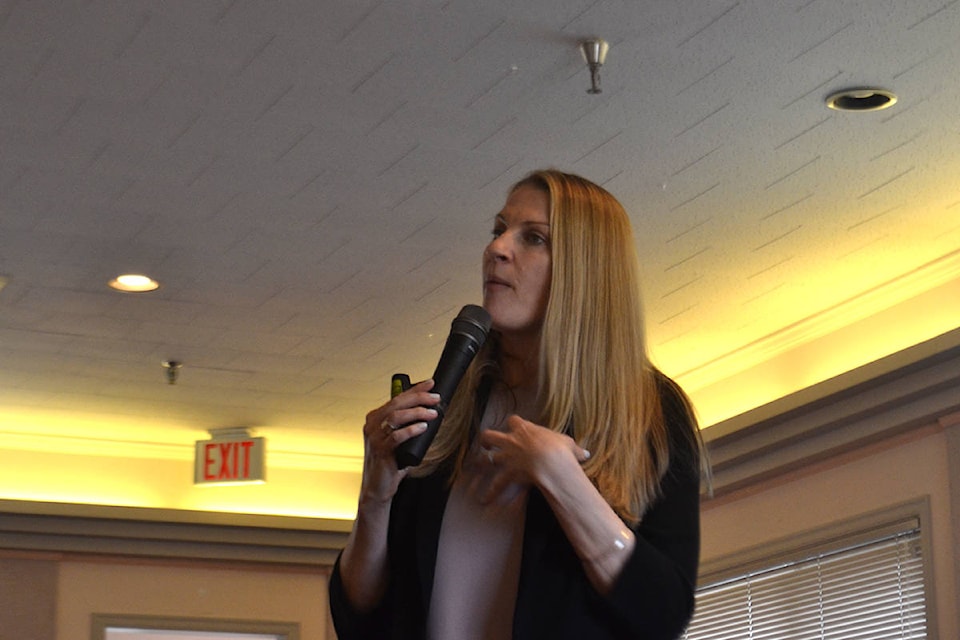The Age-Friendly Society hosted an information presentation focusing on dealing with stress and anxiety coping mechanisms at the Valley Room on April 24.
It was hosted by Kristin Buhr, a registered psychologist and the director of the North Shore Stress and Anxiety Clinic in North Vancouver. She presented a series of sessions in 100 Mile House earlier in the year at Peter Skene Ogden Secondary School and at the Community Hall.
“Looking around the room, it makes me feel good to know that she just had so many key messages for all of us. It was great,” said Lea Smirfitt, the South Cariboo Age-Friendly executive director and organizer of the event. “My take away was [that] there are definitely ways that you can change your thoughts and behaviours and build resilience so you can cope with things coming down the line.”
Buhr said the human body uses anxiety as an important survival mechanism that is adaptive and protective. She likened it to an internal smoke alarm and if humans did not have anxiety, they would be dead.
“So if we think about what happens when our body perceives some type of threat - you’re out for a walk in the woods and a bear jumps out or you’re out for a walk and this dog someone let off its leash comes towards you and it’s foaming at the mouth - our bodies go, ‘that’s dangerous, I need to protect myself,’” she said during her presentation.
Three things happen when someone sees a threat. Thoughts picture the worst case scenario, the body prepares to protect itself and then the person takes action, whether it’s fight or flight.
However, there are problems. Sometimes the internal smoke alarm can go off when there is no actual fire or in some cases, it just doesn’t turn off.
There are different types of anxiety and Buhr described several ways to help take control of them and cope with several different anxiety-based problems.
Cognitive Behaviour Therapy (CBT) strategies are based on the model of human experiences broken into four parts; thoughts, behaviours, emotions and physiology. It is also what Buhr uses to help her patients and recommends for dealing with stress.
When someone is struggling with anxiety, all four parts change but it’s important to work on making them into positive experiences by using positive self-talk can help alter the cycle.
She also recommended facing fears head-on. Buhr used a young girl she has a patient as an example.
The girl is afraid of dogs and Buhr is teaching her to face her fears by exposing her to dogs on videos, talking about dogs and eventually by introducing her to dogs.
“If we change how we think and we change how we act and what we do, then we can change how we feel,” she said.
Phobias are one of the anxieties, where the fear of a particular object like a spider creates anxiety that is a disproportionate reaction to the actual threat.
Sometimes those fears are enough to cause enough distress it can disrupt someone’s life. An example Buhr used was a person with a crippling fear of flying may actually get into an accident before even getting to the airport.
Two other types that Buhr said are very common are separation and social anxiety.
The former is when being separated from loved ones or attachments can cause great distress, wondering if something bad will happen to the person with the anxiety or to the one(s) they are separated with.
Buhr said separation anxiety would likely be common in the community due to the 2017 wildfires and the evacuations.
Social anxiety is when people worry far too much about what others think about them. This can cause people to miss out on social events or even go to school. It can interfere with their life and cause a lot of isolation.
General anxiety is a case of “what if?”
“The thing that is interesting about general worry is that it’s not one thing. You worry about work or school, you can worry about some health problems, your children’s safety, a bunch of things,” she said. “It has to do with excessive and uncontrollable worry.”
